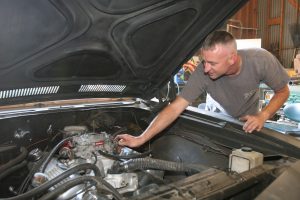Contents
Hill-start assist: what it does
How the hill-start assist works
Hill-start assist: maintenance
You have probably already experienced that your car’s brakes jam when you start up again. Now you know that this is not a fault, and you are not necessarily at fault, because it is, in fact, the effect of an equipment option in your vehicle, the hill-start assist.
Hill-start assist: what it does

Definition
Hill-start assist assists you by locking the brakes until you re-engage the clutch; once the vehicle moves forward, the system gradually releases the brakes.
Not all drivers can master hill starts: it is difficult to prevent the vehicle from rolling backwards at this precise moment; moreover, the manoeuvre requiring coordination of movement between the acceleration, brake and clutch pedals often leads to unexpected engine stalling.
Its advantages
Hill-start assist is handy as it prevents backward movement, which can lead to crumpled metal, stalling and stress for the driver in a delicate situation. It is an automatic, self-adapting system without manual intervention, which is inexpensive.
The system has practically no disadvantages, as it does not increase the weight or size of the vehicle and adds very little to its technical complexity. The only problem is that it is almost impossible to install it on a car that is not initially equipped.
Operation of the hill-start assist

The components of hill-start assist
A hill-start assist system consists of sensors, a computer and actuators, whose functions are described below:
The wheel sensors are hall-effect or magneto-resistive sensors common to ABS and ESP systems (anti-lock braking and traction control systems), sensitive to a very low wheel rotation speed, which detect the start of movement of the wheels in reverse to engage the system and the rotation of the wheels forwards to disengage. There are two types:
- a vehicle inclination sensor indicating the gradient of the slope;
- accelerator and clutch pedal position sensors that detect engine load and clutch point.
The hill-start assist computer is often the same as the ABS-ESP computer with this function added (it may also incorporate emergency braking).
The actuators are the hydraulic unit of the ABS system, which generates the pressure for locking the brakes, or the motors of the electric handbrake, which operate the brake callipers.
It goes without saying that such equipment cannot do without electronics. As with all intelligent vehicle systems, the operating principle of this technology is as follows:
- The sensors convert physical quantities (pressure, position, speed, temperature, etc.) into electrical signals and send this information to the computer;
- The computer sorts this information and electrically controls the actuators accordingly;
- The latter, which are coils (electric motors, ignition coils, injectors, relays, etc.), transform the electrical energy received into mechanical action.
Hill-start assist: maintenance
This system is often offered as standard on the vehicle with ABS-ESP. If it is optional, the extra cost is often minimal.
Maintenance of the system is reduced to a minimum as it is an integrated function, requiring no additional components on the vehicle.
A malfunction will therefore be caused by a failure of the ABS and ESP components, resulting in their operation being neutralised by the control electronics. You will then need to call a professional mechanic.
Hope this post has been informative to you. Remember to share your thoughts in the comments below. The following posts might also please you, or if you wish to read on a more specific car topic, please let us know!.




